![13 Relationship Statistics [New 2024 Data]](https://wp.bedbible.com/wp-content/uploads/2024/05/Relationship-Statistics.png)
There are a lot of statistics and facts about love, relationships, and marriage available. But no one gives you the full overview. We’ve decided to make a report that includes all you need to know. In other words, you’ll find the newest stats and facts on the most popular and interesting topics in love, relationships, and marriage.
So whether you’re interested in comparing your relationship or marriage to others, or if you’re a journalist looking for valid and reliable data, then you have come to the right place.
Table of contents:
- General facts about love, marriage, and relationships
- Men
- Women
- Teen
- Marriage
- Dating
- Health
- Fun Facts
- College
- Gen Z and Millenials
- Age Gaps
- Long-distance relationships
- Dealbreakers for relationships
- About Bedbible.com
- Use of data
Key Takeaways
- 2 out of 3 people go back to their first lover
- Single moms are 10% faster to find love
- 58% of couples have sex weekly
- 29% of men have thought about leaving their partner
- 1 out 5 men cheat
- 30% of teens had sex
- 50% of all marriages end in divorce
- It’s healthy to be in love: 12% less likely to get the vascular disease
- 9 out of 10 Navy Seal soldiers get divorced from their partner
- You can get 1 year in jail for having an affair if you live in Michigan
- 4 out of 10 Americans (39%) who have been married since 2010 have a spouse who is in another religious group. The majority of these interfaith marriages are between Christians and those who are religiously unaffiliated.
- All kinds of exercise; strength training, cardio, etc. are going to improve your performance in bed
1. General facts about love, marriage, and relationships
This section gives you a good overview of love in the world.
After reading this you’ll better understand the proportions and the current status of romance in the world.

2 out of 3 persons (66.67%) go back to their first lover
- First love reunited statistics: Is it common to reunite with first love? The quick answer is; yes. Many studies show that people think it’s pretty rare, but that’s not the case. 2 out of 3 people (66.6667%) get back to their first lover.
- This can be explained by several parameters, but the biggest explainer is that your first love is typically more intense than the others. Further is your first love typically in your 20s. Where you form and develop your identity, and doing that with another person is just special. Often people also find friends together. So in general a lot of parameters bind people to each other. This is also why the majority goes back to that comfortable and “easy” choice.
- It’s not only about forming and developing a social identity, it can also be about setting your sexual preferences. A younger couple tends to explore more, it could be by using vibrators, an anal training kit, or exploring beginner BDSM toys. This might later on when getting a more settled lifestyle be what one is longing for, the thrills of public play with remote sex toys or maybe some strap-on play.
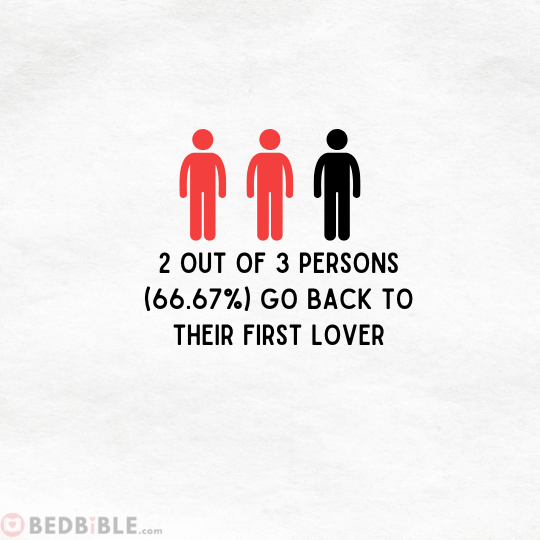
How often do couples make love (have sex)?
- We can divide couples into; Married couples and not-married couples (so just normal partners). These two categories are between 18 – 44 years old.
Married couples
46%: weekly or more
37%: 1-3 times a month
7%: 1-2 times a year
10%: no sex the last year
Not-married couples (normal partners)
58%: weekly or more
35%: 1-3 times a month
5%: 1-2 times a year
2%: no sex the last year
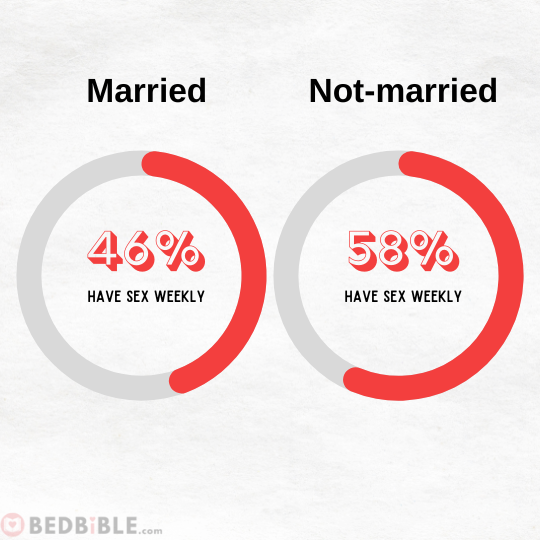
2. Men
Facts about love and statistics on love are often difficult to catch. Since a lot of the data is not frequently shared by people. Since both partners remember the relationship differently.
The statistics about love from the men’s perspective is therefore the focus area in this section. Here you’ll find facts about love that is related to him.
Who says I love you first?
- Saying I love you after sex is the most probable scene where the historical words “I love you” will be said.
Evidence shows that men in most cases say “I love you” before women. It’s a 3:1 ratio. So for every 1 woman that says it, 3 men do it. Further, do men on average say it 42 days sooner than women?
- The report also states that in most cases where no one says “I love you” after 1 year typically ends up in a relationship that’ll end.

How many men think about leaving their partner?
- Only 29% of men consider leaving their partner. That’s a smaller number than women (here 38% of women frequently do that). Further, around 62% of men are sure that they love their partner. That’s again lower for women where only 38% is certain about that. In other words, data tells us that men are more certain about whether they love their partner or not.
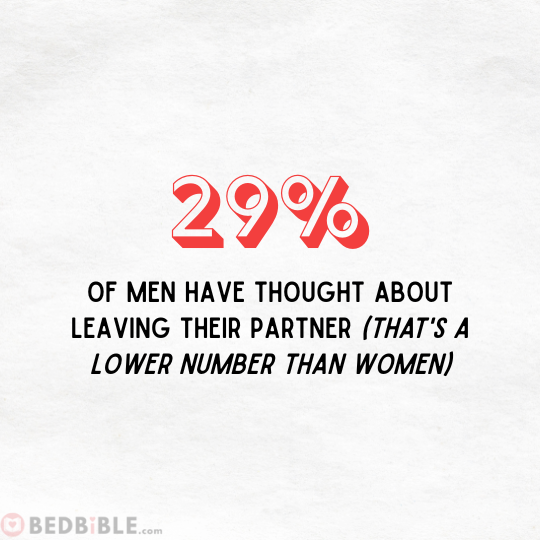
Who cheats more men or women?
- 20% of married men cheat on their spouses, and 13% of married spouses cheat.
- 65% of those who cheat stop it within the first 6 months, indicating that they slowly adapt to their new relationship status.

- Why do people cheat (have an affair)?
44% of men want sex more often
40% of men want variety in their sexual partner
40% of women want more emotional attention
33% of women want to be reassured they’re still desirable
3. Women
Likewise, all relationship and love statistics about women are here gathered and presented.
Try to compare the two genders’ data. Anything that surprises you?

Single mothers finding love
- The population of single moms is 22 million in the US. This, therefore, makes the milf-market one of the biggest when we talk about dating.
- Our research shows that single moms find love quicker than everyone else. They find love 10% faster than the average dater. The research did unfortunately not show why, but our best guess would be that they’re more effective in their dating approach. So basically, they know what they look for, and are a bit busier. They do not have the same time as everyone else.
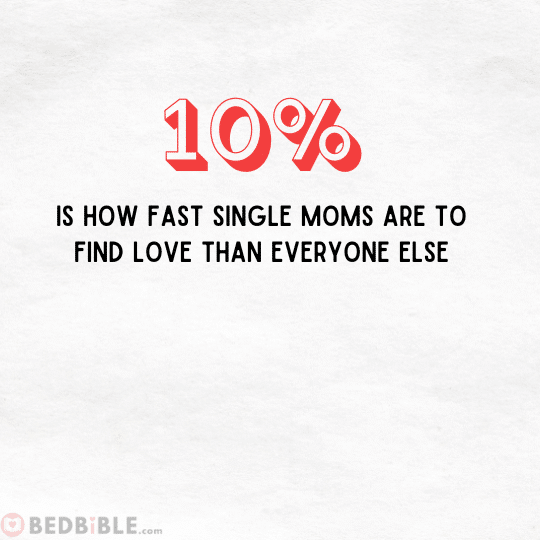
It takes longer for women to fall in love
- Most people asked in the survey thought women fell in love more quickly than men. But that’s not the case. It’s both men that say “I love you” first (as mentioned above), but also fall in love at first.
- This typically leads to male frustration since they hate to be the one that falls in love first (for some reason) – guess it’s something about pride. So if you’re a man, don’t worry at all. Commonly, you feel a bit more for your partner now than she does for you. Be nice and patient, and everything will be fine!
Intimate partner violence: Among female victims, 94% of these are 16-19 year old
- The most intimate partner violence happens with younger boyfriends and girlfriends. Women are typically the victims of this.
- 94% of intimate partner violence is females between 16-19 years old
- 70% of intimate partner violence is females between 20-24 years old
- In general intimate partner violence accounts for 15% of all violent crimes.
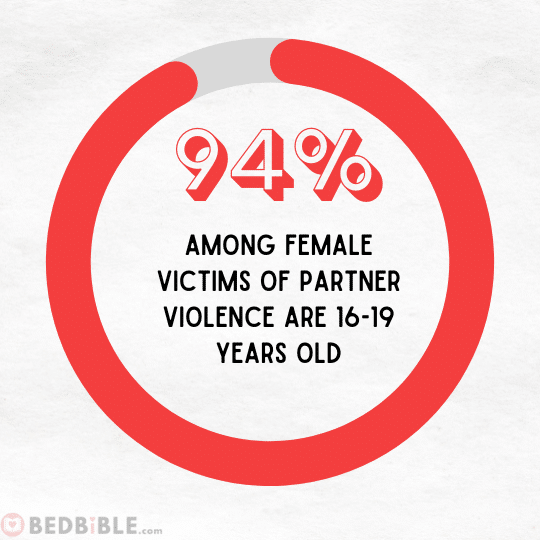
4. Teen relationships
Relationships are typically associated with teens since a lot happens at those ages.
Below you’ll find some exciting love statistics about this segment and here you can find statistics focusing on only teenagers.

19% of teens are in a relationship
- Almost 1 out of 5 teenagers are in a relationship (20%). That’s compared to all adults (18 years or older) a bit lower. 31% of all adults are single, and half of the singles are looking for a partner.
- The teenage love statistics also state that out of the 19% that are in a relationship. Only 14% categorize it as serious.
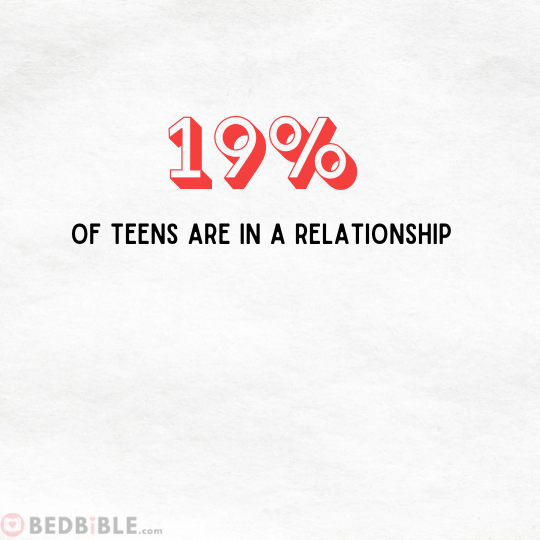
30% of teenagers had sex (almost 1 out of 3)
- The majority of teenagers are not sexually active. This is due to the age group from 13 – 19 years old.
- The report states that almost 1 out of 3 teenagers had sex. But as always when surveying teens there is a bigger error rate (than we normally see), due to factors such as irrational behavior. Some teenagers are afraid when answering such questions that their parents in some way get to know the answer. So we guess that this is a bit larger (not much, just a little bit).
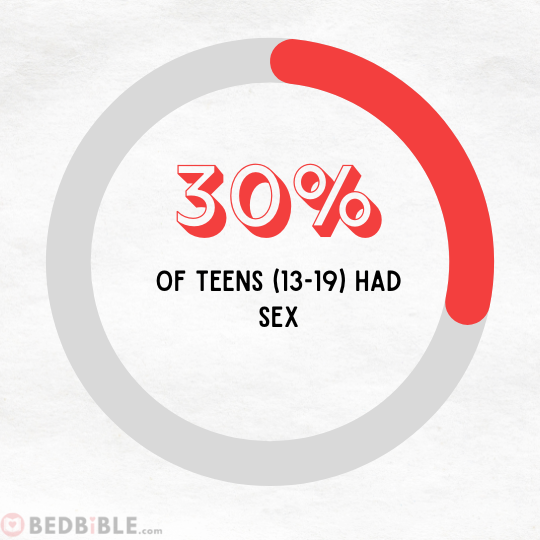
How teenagers date and act in a relationship
- Diving into Dating: 35% of teens aged 13-17 have tried dating, both casual and serious. Interestingly, 8% found their partners online, while 25% met in person.
- Committed Couples: 14% of teenagers are currently in a serious relationship.
- Flirting Techniques: 55% have flirted or shown interest in someone in person, while 50% have used social media to express their interest, be it through likes, comments, or sharing content.
- Emotional Connections on Social Media: 50% of teen boys view social media as a space for emotional connection, compared to 37% of teen girls.
- Communication in Relationships: 85% of teens in relationships expect daily communication from their partner. Breaking it down, 11% expect hourly updates, 35% every few hours, and 38% are content with daily updates.
- Keeping the Spark Alive: The top ways teen couples stay connected are through texting (92%), phone calls (87%), and meeting in person (86%).
- Regular Daters: 38% of teenagers date frequently.
- Physical Intimacy: 66% of teen couples haven’t been physically intimate, while 30% have.
- Dating Trends: Teen dating was at its lowest in 2016.
- Mental Health & Dating: Teens who don’t date are generally less prone to depression.
- Dating Violence: Alarmingly, 1 in 12 high school students have faced physical or sexual dating violence.
How Long Do Teen Relationships Last?
- Young Teens (12-14 years): Relationships last around 5 months.
- Mid-Teens (15-16 years): Relationships span approximately 2 years.
- Older Teens (16-18 years): Relationships typically last close to 1.8 years.
5. Marriage
Here you’ll find facts about marriage. Being in a marriage is not the most common marital status anymore accounting for 47.31% of the population in 2023.

Marriage and divorce
- Divorce is never a fun topic since it involves many people and not all break-ups end well.
- Almost 50% of all marriages end in a divorce, and every 42 seconds there is one getting divorced in America. Adding that number up; 746.971 get divorced every year in the US. There is also a 1:3 ratio of marriage vs. divorce. So every time a couple gets married 3 get divorced.
- The average length of a person’s first marriage is 8 years, and the average age to get the first divorce is 30 years old.
- Not being religious increases the probability of being divorced by 14%.
- High IQs are more likely to stay in the relationship than vice versa (actually 50% more likely)
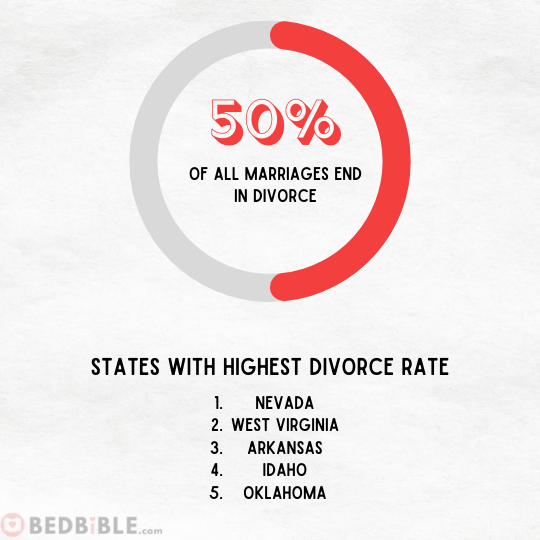
Marry for love or money
- Marrying for money has always been a topic that people talk about. We have all heard about the typically older men who marry younger women, and who all around them suspect the women of being together with the man because of the money. All available research indicates that money from generation to generation is important when choosing a partner. 56% of Americans say they prefer financial security higher than falling deeply in love with their partner.
- It’s only Generation Z (born between 1996 and 2010) that prioritizes love (54%) over money.
6. Dating
Dating is where relationships and love start, and there are some fun stats on this.
We’ve captured them all so you can compare your own experience with the rest.

53% lie on their online dating profile
- Further, research shows that 20% of women use a more than 2 years old picture. Guess this is the guy’s worst nightmare.
- But but but … men are not better. 40% lie about their jobs to be more successful in the eyes of their date.
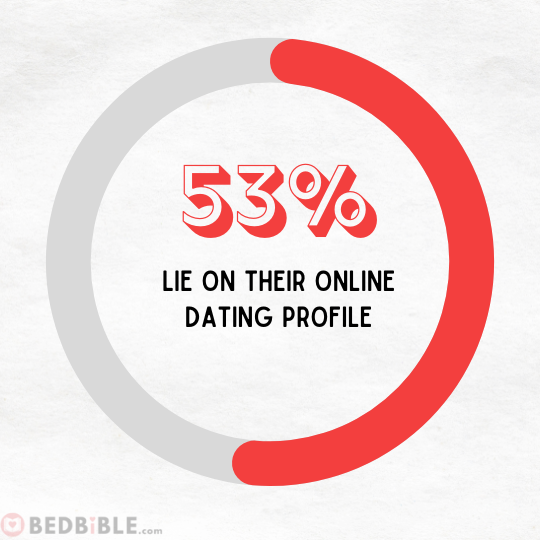
The chances of finding love without looking are 1 to 562
- We often see movies where people randomly meet each other. And we, therefore, somehow, have a misunderstood conception that a lot of people meet each other like this. 45% meet each other through mutual friends and only 7% find love through online dating apps.
It takes 4 minutes to decide whether you like someone or not
- The first impression is the most important. Since this is where you give the person the so-called “elevator eyes”. So remember to be the best version of yourself when meeting new people. Bear in mind that chances are that you meet your new girlfriend/boyfriend, and then you want to make a good first impression. Else will the other person categorize you as a “no”.

7. How Relationships Impacts Health
Love has some positive impacts on your life and health. We’ve listed the most interesting here.
It is fascinating how much you are affected by your love for another person.

Cuddling your loved one releases painkillers
- When you’re together with your loved one, your body knows it and reacts to it. In-depth research has investigated what happens with your body and mind when you’re around someone you truly love. Scientists have found something they called the “cuddle hormone” which is also known as Oxytocin. This hormone is in the brain and gets released when you cuddle your partner. This hormone decreases headaches significantly. So maybe the next time you have a headache try to cuddle with your partner before going to medicine (Nb. the headache should go away within 4 hours after you start the cuddle).
- It’s also known that just when you look at a picture of a loved one the body releases natural painkillers.
You become a better person when you’re in love
- When you’re in love you have more surplus and want to talk/help other people. Further, you push yourself to develop both in a psychological way as well as pushing yourself when running/doing fitness. When you’re in love you also decrease the level of neurosis (a mental disorder involving chronic distress)
You are 12% less likely to get a vascular disease if you’re married and under 50 years old
- This has something to do with your level of happiness and the fact that when you’re together with another person. You tend to be more active which of course is good for your health.
8. Fun Facts on Relationships
In this section, you’ll find all the fun facts about love, marriage, and relationships.
Check the facts and stats and see if you are surprised about some of the findings. We guarantee that we have at least 1 love statistic which you’ve never heard before.

Can you go to jail for cheating?
- Yes! In Michigan, USA adultery is a felony crime, and you can be prosecuted by your spouse/partner. The penalty framework is a minimum of 1 year in jail. So maybe it’s good to be up to date with the regulations in your country.
U.S. Navy Seal divorce rate
- The divorce rate for some of the world’s best soldiers is 90%. So 9 out of 10 Navy Seal soldiers get divorced from their partner.
Long-distance relationships have more happiness and trustfulness
- It is pretty common for people to say that long-distance relationships do not work. And that’s of course also correct in a lot of cases. But in fact, our research and data show that these relationships are more related to; Trust, satisfaction, and happiness.
How many couples are happy in their relationships?
- Love statistics show that 83% are happy in their relationship.
9. College relationships
We’ve conducted full-fledged research into the subject of sex in college as well as cheating in college relationships. Some of the insights provided below draw on results from that research.
- A majority of college students prefer serious relationships: 63% of men and 83% of women.
- Less than 15% of college students engage in hook-ups more than twice a year.
- 20% of students aged 19-21 fall in love for the first time during their initial college years, compared to 8% of those aged 22-25.
- 78.2% of college students have a sexual partner who is either their spouse or a significant other.
- 73% of college students have been in love at least once.
- 75% of college students have experienced a long-distance relationship.
- Nearly 40% of college students are virgins.
- 28% of relationships that last after college are between partners from the same institution.
10. Gen Z and Millenials
- 16% of Gen Z couples meet through dating apps, while 26% of millennial couples do the same.
- School is a common meeting place: 25% of Gen Z couples meet in college or grad school, compared to 18% of millennials.
- High school relationships are more common for Gen Z, with 17% meeting there, in contrast to 6% of millennials.
- Childhood friendships turning into relationships are slightly more common for Gen Z at 5%, compared to 3% for millennials.
- The workplace is a more common meeting spot for millennials at 18%, compared to 11% for Gen Z.
- Social settings like bars and concerts are less popular for Gen Z, with only 6% meeting there, while 11% of millennials meet in such settings.
- Gen Z places a higher emphasis on financial independence, career success, and homeownership before focusing on love.
- Gen Z values open communication and honesty in relationships, often influenced by the digital age’s transparency. They are also more likely to discuss mental health openly with their partners, emphasizing emotional well-being in relationships.
11. Age gaps
- The typical age difference in heterosexual relationships is around 2.3 years.
- In Western countries, 8% of heterosexual couples have an age gap of 10 years or more. This percentage rises to 25% for gay couples and 15% for lesbian couples.
- Only 1% of male-female relationships feature an age gap of 28 years or more.
- The likelihood of divorce increases with a larger age gap. Couples with a 20-year age difference face a 95% likelihood of divorce. This drops to 39% for those with a 10-year gap and 18% for a 5-year difference.
12. Long-distance relationships
At the Bedbible Research Center, we’ve previously looked into long distance relationship statistics, and the below findings draw on this research.
- 58% of long-distance relationships work out, while 42% fail.
- 16.09% of people are currently in a successful LDR.
- 81.12% of people have been in an LDR at some point.
- 51.11% of relationships started as a long-distance relationship.
- 25.14% of people have experienced infidelity in an LDR.
- On average, long-distance couples live 125 miles apart and expect to reunite within 14 months.
- The most common reasons for LDR failure are lack of planning (70%), cheating (12%), and growing apart (9%).
- The biggest obstacles in LDRs are loneliness (72%), absence of physical intimacy (66%), and jealousy (54%).
- 5.95% of married couples are currently in an LDR, with 27.29% having experienced infidelity.
- 32.51% of college students are currently in an LDR, with 19.75% having experienced infidelity.
- Couples in LDRs have contact 4 times a week, send 347 online messages a week, call each other 2.59 times a week, and meet up once every 20 days.
- 33% of couples that reunite break up after just 3 months of reuniting.
- 5.1% of LDR couples have decided on an open relationship.
- 11% of LDRs have never met in person.
- 81% feel more intimate after reuniting, but only 5% feel closer together.
- 32% who were in an LDR would not do it again.
- Just 2% of high-school couples survive becoming long-distance when starting college.
13. Dealbreakers for relationships
The most significant deal breakers for individuals when considering a partner are related to personal hygiene and behavior.
A disheveled or unclean appearance tops the list at 67%, closely followed by laziness at 66%.
Interestingly, factors related to personal habits and preferences, such as watching too much TV, playing video games having a low sex drive, or being stubborn, are less of a concern, each at 33%.
This suggests that personal appearance and behavior traits are more crucial in the initial stages of considering a relationship.
| Deal Breaker | Percentage |
|---|---|
| Disheveled or unclean appearance | 67% |
| Lazy | 66% |
| Too needy | 63% |
| Lack of sense of humor | 54% |
| Lives more than 3 hours away | 49% |
| Bad sex | 47% |
| Lack of self-confidence | 40% |
| Too much TV/video games | 33% |
| Low sex drive | 33% |
| Stubborn | 33% |
About Bedbible.com
Bedbible.com is publicly known as the biggest sex toy review site in the world.
Less known is, that we have a research team that produces in-depth analyses and research about love, romance, dating, and sex toys. We do this because the educational part is a priority of ours.
There is no sponsor behind the research. All our research activities are 100% independent.
You can find all our published reports here.
Use of data
Feel free to use any information from the study with reference to https://bedbible.com. For any additional details or access to the raw dataset quotes from relationship experts, or couples feel free to reach out to the Bedbible Research Center at researchcenter@bedbible.com
